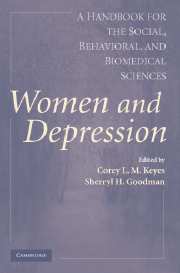Book contents
- Frontmatter
- Contents
- List of Contributors
- Foreword
- Preface
- PART I NOSOLOGY, MEASUREMENT, AND THE EPIDEMIOLOGY OF WOMEN AND DEPRESSION
- PART II BIOLOGICAL, DEVELOPMENTAL, AND AGING MODELS OF RISK
- PART III COGNITIVE, EMOTIONAL, AND INTERPERSONAL MODELS OF RISK
- 7 Cognition and Depression
- 8 Personality and Depression in Women
- 9 The Social Costs of Stress
- 10 Marriage and Depression
- 11 Depression in Women Who Are Mothers
- PART IV SOCIAL, POLITICAL, AND ECONOMIC MODELS OF RISK
- PART V SYSTEMS AND PROCESSES OF TREATMENT, PREVENTION, AND POLICY
- Author Index
- Subject Index
- References
10 - Marriage and Depression
Published online by Cambridge University Press: 05 June 2012
- Frontmatter
- Contents
- List of Contributors
- Foreword
- Preface
- PART I NOSOLOGY, MEASUREMENT, AND THE EPIDEMIOLOGY OF WOMEN AND DEPRESSION
- PART II BIOLOGICAL, DEVELOPMENTAL, AND AGING MODELS OF RISK
- PART III COGNITIVE, EMOTIONAL, AND INTERPERSONAL MODELS OF RISK
- 7 Cognition and Depression
- 8 Personality and Depression in Women
- 9 The Social Costs of Stress
- 10 Marriage and Depression
- 11 Depression in Women Who Are Mothers
- PART IV SOCIAL, POLITICAL, AND ECONOMIC MODELS OF RISK
- PART V SYSTEMS AND PROCESSES OF TREATMENT, PREVENTION, AND POLICY
- Author Index
- Subject Index
- References
Summary
As has been noted throughout this volume, women are nearly twice as likely as men to experience depression in their lifetime (Nolen-Hoeksema, 1987). Cross-national studies have demonstrated that this is true in both Western and non-Western countries (Weissman et al., 1993). As has been discussed elsewhere (e.g., McGrath, Keita, Strickland, & Russo, 1990; Nolen-Hoeksema, 1987) and throughout the chapters of this volume, there are numerous explanations that have been advanced to account for this gender difference.
This chapter is devoted to evaluating a social explanation for gender differences in depression; namely, that this gender difference could be due, in part, to gender differences in experiences in marriage. It has been shown that the potential exposure to marital distress and other negative relationship outcomes such as divorce is very widespread. For example, it has been estimated that within the United States, 9 out of every 10 Americans marry at least once in their lifetime (Kreider & Fields, 2001), that many people who do not marry will live with a partner in nonmarital familial relationships (Seltzer, 2000), that approximately 16–20% of individuals are dissatisfied with their marriages or cohabiting relationships at any given time (e.g., Hjemboe & Butcher, 1991), and that nearly 50% of recent marriages may end in divorce (Kreider & Fields, 2001).
- Type
- Chapter
- Information
- Women and DepressionA Handbook for the Social, Behavioral, and Biomedical Sciences, pp. 219 - 240Publisher: Cambridge University PressPrint publication year: 2006
References
- 15
- Cited by



